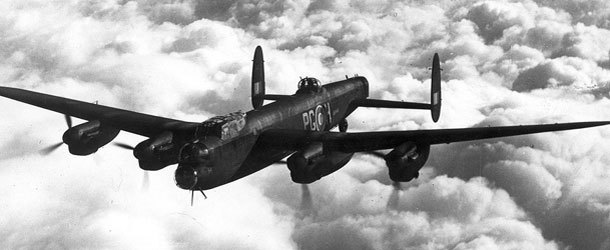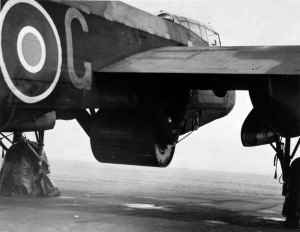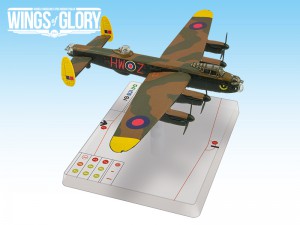Following the article about the B-17 four-engine bomber, let’s take a closer look to the Avro Lancaster, the definitive heavy bomber of the British in WW2 and one of the most associated with the Royal Air Force night offensive over Germany. With more than 7,300 units built and about 156,000 sorties, the Lancaster dropped roughly 608,000 tons of ordnance on the enemy.

The Lancaster G for George of No. 460 Squadron RAAF, now in the collection of the Australian War Memorial.
The Avro Lancaster was developed from the two-engined Avro Manchester, a capable but underpowered airplane with a troubled Rolls-Royce Vulture engine. The failure of the Manchester with only 200 units completed, nearly led the Ministry of Aircraft to switch to Handley Page’s Halifax design, but Avro's Chief Designer, Roy Chadwick, was already working on the development of the Manchester III (which would become Lancaster), by revising the design to include an additional pair of engines (preferably the well-proven Merlin).
A contract was signed with Avro for two prototype aircraft in September 1940, and the first was ready to fly within four months - on 9 January 1941. This prototype was basically the revised Manchester, with the key difference of the four 1,145 hp Rolls-Royce Merlin engines, on a larger wing. A second prototype followed in May 1941, with larger tail fins, a new undercarriage and improved Merlin engines. The development was speedy, with test flights throughout the summer, and a production quality version was airborne by the end of October 1941.
The Lancaster Mk.I could reach the maximum speed of 287 mph, with four 1,280 hp Rolls Royce Merlin engines. The standard operating crew was seven members - pilot, bombardier, navigator, flight engineer, radio-operator, dorsal gunner and rear gunner. Originally it had a bomb bay intended to carry up to 4,000 pounds of ordnance, but later versions were modified to carry single high explosive bombs of 8,000, 12,000, 14,000 and the massive 22,000 pound ‘Grand Slam’ - the largest carried by any aircraft in the war. For defense, the Lancaster was armed with eight .303 Browning machine guns (two in the nose, two in a mid-upper turret and four in the tail). Early models also had ventral turret with a single .303 machine gun.
The first Avro Lancaster bombers were delivered by late December 1941, entering service in February 1942, with the No 44 and 97 Squadrons. The new aircraft took part in the bombing raid on Essen, in the night of 10th/11th March 1942. The Lancaster bombers formed 59 Bomber Command flying groups. Almost half of all units delivered during the war (3,345 out of 7,373) were lost on operations at the expense of over 21,000 crew members.
The Avro Lancaster was the choice of the United Kingdom's Bomber Command to face the challenge to destroying German dams in the Ruhr Valley, in May 1943, codenamed mission Operation Chastise. The operation was carried out by 617 Squadron in modified Mk IIIs carrying special drum-shaped bouncing bombs designed by Barnes Wallis (later inspiring the film "The Dam Busters"). The bomber was also employed in sinking the Bismarck-class battleship Tirpitz in a Norwegian fjord, in late 1944, using the incredible 12,000lb 'Tallboy' and 22,000lb 'Grand Slam' bombs.

One of the two airworthy Lancaster preserved, on display at the Canadian Warplane Heritage Museum (CWHM).
As the war in Europe drew to a close, the Lancaster was readied for service against Japan as part of Bomber Command’s ‘Tiger Force’. Japan’s surrender canceled this plan. Apart from its primary bombing tasks, the versatile Lancaster was also used for maritime surveillance, photo reconnaissance missions and, later, as an engine test platform. The final airframe was delivered in February 1946, but the plane flew for many years in civilian guise and as a warplane when sold to other nations – Argentina, Australia, Canada, Egypt, France, Poland and Sweden. Several Lancasters were preserved and can be seen at museums, but only two airworthy examples remain, one with the RAF's Battle of Britain Memorial Flight and the second based in Canada.
Avro Lancaster in Wings of Glory
The two Avro Lancaster bombers featured in the WW2 Wings of Glory Special Packs are the Mk.III “Grog’s the Shot” and Dambuster “Popsie.” The Lancaster BIII, or B Mk.III, were powered by improved Merlins and, along with the B.I, was the standard mount of many Lancaster squadrons.
“Grog’s the Shot,” HM-Z, LM739, was delivered to the 100 Squadron at Grimsby, England, in September 1944. In April 1945, the Squadron was relocated to RAF Elsham Wolds, and a small numeral '2' was added to the aircraft code letter on the nose and rear fuselage (Z-Zebra) because there were two squadrons with aircraft coded 'Z' on the Station. LM739 undertook 60 operations plus five 'Manna' food drops and one 'Exodus' PoW repatriation, and was scrapped in October 1945.
Dambuster "Popsie," AJ-P, ED909/G, was one of the modified Avro Lancaster B Mk III Specials known as “Type 464 Provisioning” that took part in Operation Chastise, in May 1943. This attack was carried out on three major dams that provided water and power to the Ruhr industrial region in Germany: the Möhne, Eder and Sorpe.
The “Popsie” departed on May 16th. Its crew was formed by pilot Harold Brownlow Morgan, navigator Jack Frederick Leggo, bomb aimer Robert Claude Hay, flight engineer Ivan Whittaker, wireless operator Leonard Chambers, front gunner Bertie Towner Foxlee and rear gunner Thomas Drayton Simpson. The AJ-P was the third aircraft to attack the Mohne dam and the second to return.
Two of the primary targets of Operation Chastise were breached and wide spread damage was caused by flooding. Germany's manufacturing industry, communications and various other services were also interrupted. Of the 133 aircrew flying in 19 aircraft, 53 died and another three became prisoners of war, with eight aircraft failing to return.
Information sources: Royal Air Force, Warbird Alley, Military Factory, Wikipedia, Lancaster Archive, The Dambuster, "Last of the Lancasters" (Martin W Bowman, Pen and Sword), "Lancaster Squadrons 1944-45" (Jon Lake, Osprey Publishing, 2002), Dambusters Blog - Popsie's crew.












